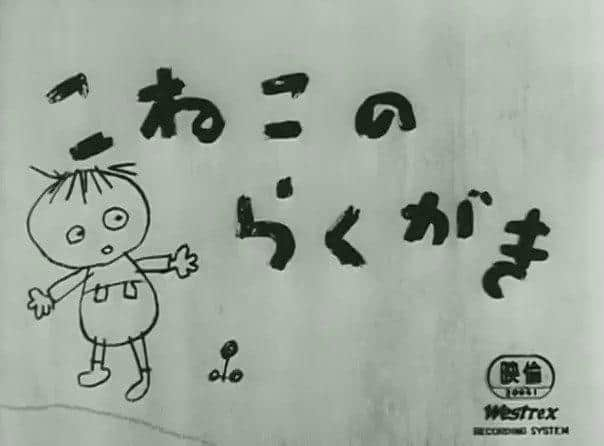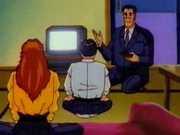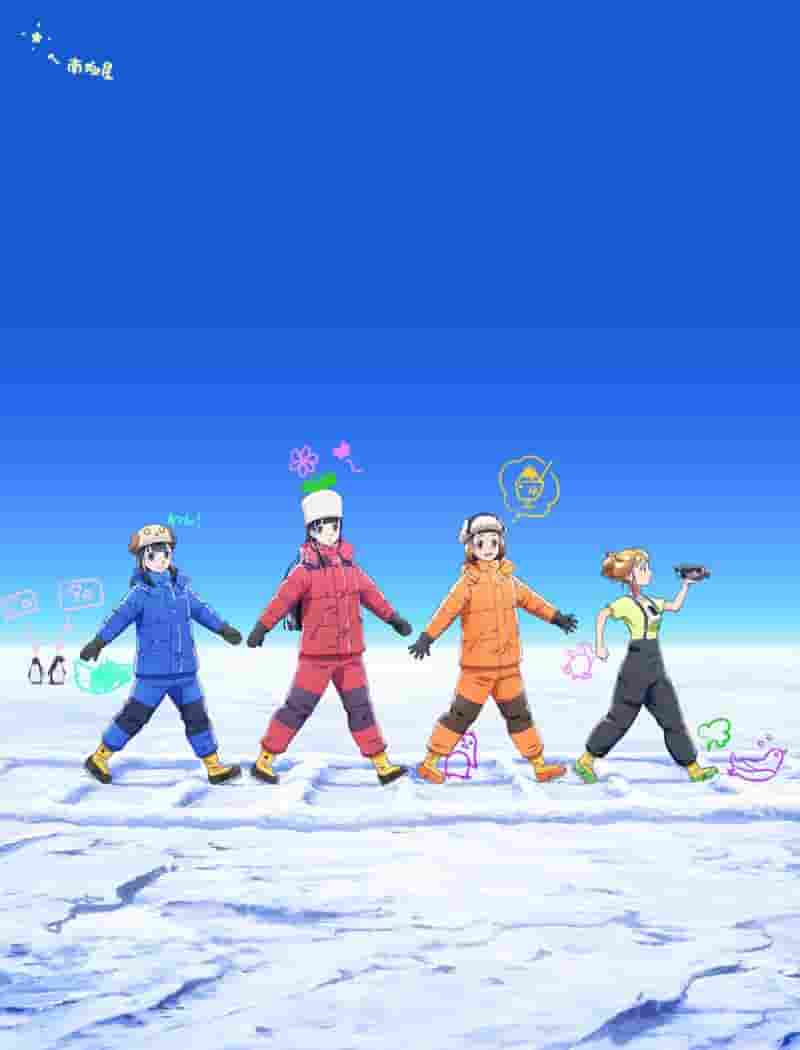"Koneko no Doodles" review: A detailed explanation of the charming cat doodle animation

"Kitten's Scribbles": Toei Animation's memorable first film■ Public Mediatheater ■ Original MediaAnime Original ■ Release dateMay 13, 1957 - January 1, 0000 ■Distribution companyToei ■Frequencies13 mins ■ Number of EpisodesEpisode 1 ■Original StoryAkio Kinoshita ■ DirectorTaiji Yabushita ■ ProductionToei Educational Film Department ■ StoryA mischievous kitten draws graffiti on a white wall. Two mice who were watching tease him and take his pencil, so he gets on the graffiti locomotive and starts a chase. The mischievous kitten is found by the bear man and erases the graffiti. ■ExplanationThe first memorable film made by the staff of the former Nichido at Toei Animation. Although it is a small black and white piece, it is a wonderful full animation not seen in TV anime, and is an honorable mention that the staff had fun making it freely. Selected by the Ministry of Education, it won an award at the 1957 Educational Film Festival. ■ Main staff・Planning: Koichi Akagawa, Sanae Yamamoto ・Direction: Taiji Yabushita ・Illustration: Yasuji Mori, Akira Daikuhara, Shoji Ichino, Sumiko Naganuma, Takashi Uchiyama, Kao Terachi, Minoru Tajima, Kiyoshi Nakajima (no NFC listed), Mitsuko Shindo, Junji Yamada and others ・Music: Nobuji Ito ・Cinematography: Mitsuaki Ishikawa ・Sound recording: Westrex RECORDING SYSTEM The appeal and evaluation of "Koneko no Doodles""Kitten's Scribbles" is a black and white short animated film that was released in 1957 and is the memorable first work of Toei Animation. This work is the first work produced by staff from the former Nichido Animation at Toei Animation, and its historical significance is very great. In the short time of just 13 minutes, the staff freely exerted their creativity and completed a magnificent full animation. This work has received high acclaim, winning an award at the 1957 Educational Film Festival and being selected by the Ministry of Education. The story is quite simple. A mischievous kitten starts scribbling on a white wall. Two mice, who have been watching, tease him and steal his pencil, and a chase ensues on the scribbling locomotive. They are eventually found by the bear man, who has to erase the scribble. Despite this simple story, the movements and expressions of the kitten and mice are depicted so realistically that it has the power to draw the viewer in. The appeal of this work lies above all in the quality of its animation. Even though it is a black and white work, the movements and expressions of the characters are drawn in great detail, giving it the smoothness and realism that only full animation can provide. The backgrounds and props are also carefully drawn, creating a landscape reminiscent of Japan in the 1950s. In particular, the scene where the kitten draws graffiti and the scene where they are chased on a locomotive are scenes that show off superb animation techniques. The music is also an important element that enhances the appeal of this work. The music by Ito Nobuyuki flows lightly in time with the movements of the kitten and mouse, entertaining the viewer. In addition, the sound effects are realistically reproduced by Kimura Hajime, so the work can be enjoyed not only visually but also aurally. "Kitten's Scribbles" was also produced as an educational film. Therefore, it contains a message aimed at children. The mischievous kitten finally erases the doodle, teaching the importance of taking responsibility for one's actions. In addition, through the various characters, such as the kindness of the bear man and the mischievousness of the mice, you can learn about human relationships and morality. This work is highly regarded for its educational value, as evidenced by the fact that it won an award at the 1957 Educational Film Festival and was selected by the Ministry of Education, making it particularly meaningful in terms of teaching children morality and a sense of responsibility through animation. In addition, as this was Toei Animation's first work, it had a major impact on the development of Toei Animation. The staff were free to use their creativity to create a stunning full animation, and this work can be said to be the origin of Toei Animation. It is no exaggeration to say that it built the foundation for many classic animations, such as "Astro Boy" and "Dragon Ball," which came later. "Koneko no Dakugaki" is a black and white short animation, but it is packed with many elements, such as the quality of the animation, the appeal of the story, and educational value. Although it was made in 1957, its charm has not faded even now, and it is a work that can be enjoyed by children and adults alike. In particular, it is a work that should be seen at least once by anyone interested in the history of animation and the origins of Toei Animation. The production background and staff of "Koneko no Doodles""Kitten's Scribbles" is the memorable first work produced by staff from the former Nichido Animation Co., Ltd. before the war, which was absorbed into Toei Animation after the war. Toei Animation was a new studio that had only just been established in 1956, and "Kitten's Scribbles" was its first work. The director of this work is Taiji Yabushita, a veteran who has been involved in animation production since the days of the old Nichido. Yabushita later worked on many works for Toei Animation, and made a major contribution to the production of classic animations such as "Astro Boy" and "The Jungle Emperor." For "Koneko no Doodles," the staff were able to freely exercise their creativity under Yabushita's guidance, completing a stunning full animation. The animation staff included many talented individuals who would go on to support Toei Animation, such as Mori Yasuji, Daikuhara Akira, Ichino Shoji, Naganuma Sumiko, Uchiyama Takashi, Terachi Kaoru, Tajima Minoru, Nakajima Kiyoshi, Shindo Mitsuko, and Yamada Junji. These staff members were also involved in the production of later animation masterpieces such as "Astro Boy" and "Dragon Ball," and made a major contribution to the development of Toei Animation. The music was composed by Ito Senji. Ito would later go on to compose music for many other Toei Animation productions, and is particularly famous for the music of "Astro Boy." In "Koneko no Doodles," the light-hearted music that matches the movements of the kitten and mouse enhances the charm of the work. The cinematography was done by Mitsuaki Ishikawa. Ishikawa would later work on many films for Toei Animation, and his work on "Jungle Emperor Leo" in particular was highly praised. "Koneko no Doodles" is a black-and-white film, but the cinematography used to realistically depict the characters' movements and expressions is outstanding. The sound was recorded by the Westrex Recording System, which was the latest recording technology at the time and was used to reproduce realistic sound effects. The sound effects were provided by Hajime Kimura, whose realistic sound effects add to the appeal of the work. "Koneko no Dakugaki" was the first work produced by the staff of the former Nichido Animation at Toei Animation, and from the production background and staff lineup, it can be said to be the origin of Toei Animation. Many talented people who contributed greatly to the later development of Toei Animation gathered together to complete this stunning full animation, and its charm has not faded even now, making it a work that can be enjoyed by children and adults alike. Evaluation and recommendation of "Koneko no Doodle""Kitten's Scribbles" is a black and white short animated film that was released in 1957 and is the memorable first work of Toei Animation. This work is the first work produced by staff from the former Nichido Animation at Toei Animation, and its historical significance is very great. In the short time of just 13 minutes, the staff freely exerted their creativity and completed a magnificent full animation. This work has received high acclaim, winning an award at the 1957 Educational Film Festival and being selected by the Ministry of Education. The appeal of this work lies above all in the quality of its animation. Even though it is a black and white work, the movements and expressions of the characters are drawn in great detail, giving it the smoothness and realism that only full animation can provide. The backgrounds and props are also carefully drawn, creating a landscape reminiscent of Japan in the 1950s. In particular, the scene where the kitten draws graffiti and the scene where they are chased on a locomotive are scenes that show off superb animation techniques. The music is also an important element that enhances the appeal of this work. The music by Ito Nobuyuki flows lightly in time with the movements of the kitten and mouse, entertaining the viewer. In addition, the sound effects are realistically reproduced by Kimura Hajime, so the work can be enjoyed not only visually but also aurally. "Kitten's Scribbles" was also produced as an educational film. Therefore, it contains a message aimed at children. The mischievous kitten finally erases the doodle, teaching the importance of taking responsibility for one's actions. In addition, through the various characters, such as the kindness of the bear man and the mischievousness of the mice, you can learn about human relationships and morality. This work is highly regarded for its educational value, as evidenced by the fact that it won an award at the 1957 Educational Film Festival and was selected by the Ministry of Education, making it particularly meaningful in terms of teaching children morality and a sense of responsibility through animation. In addition, as this was Toei Animation's first work, it had a major impact on the development of Toei Animation. The staff were free to use their creativity to create a stunning full animation, and this work can be said to be the origin of Toei Animation. It is no exaggeration to say that it built the foundation for many classic animations, such as "Astro Boy" and "Dragon Ball," which came later. "Koneko no Dakugaki" is a black and white short animation, but it is packed with many elements, such as the quality of the animation, the appeal of the story, and educational value. Although it was made in 1957, its charm has not faded even now, and it is a work that can be enjoyed by children and adults alike. In particular, it is a work that should be seen at least once by anyone interested in the history of animation and the origins of Toei Animation. This work can be viewed on DVD and Blu-ray. It may also be available online, so if you are interested, please search for it. "Koneko no Dakugaki" is the origin of Toei Animation and is a work that brings together the best of Japanese animation technology in the 1950s. Please watch it once and experience its charm. |
<<: A thorough explanation of the appeal of "Who is the culprit?" and the joy of solving mysteries!
>>: Review of "Rainbow Feet": A moving story and beautiful visuals
Recommend
The appeal and evaluation of "Asobiniikuyo!": A new perspective on interspecies interaction
I'm Coming to Play! - A Tale of Youth in Okin...
"Re:Zero - Starting Life in Another World" Season 2 Part 2 released visual trailer to start airing in April 2024
The first half of the second season of the TV ani...
The release date of "Changjin Lake" has been extended for the third time to January 16, 2022
The release key of the film "Changjin Lake&q...
Henry Cavill talks about whether he likes Yennefer or Triss
The Netflix drama "The Witcher" starrin...
The travel comic "That's Journey" announced that it will be adapted into an animation and will be broadcast in 2025
The travel manga "That's Journey" c...
Oku Hiroya was rumored to be jealous and belittled Demon Slayer, and he was furious and said he had taken legal action
Oku Hiroya, a famous cartoonist known for "G...
Is the new photo of the heroine in Disney's live-action version of "The Little Mermaid" beautiful this time?
Recently, Halle Bailey, the heroine of Disney'...
The singer list of the world's largest anime song festival "Anime Song Summer 2023" is announced
Japan, a country with a strong anime culture, has...
Funny and bizarre! Popular American TV series "Orange Is the New Black" will end its seventh season
The super popular and bizarre American TV series ...
A new spin-off film from the John Wick universe is in production and will be announced soon
In an interview with Collider recently, "Joh...
A new chapter of the classic animation "Beastiality" is released, and Netflix will be responsible for the distribution
The second season of the extremely weird and evil...
A thorough review of the newly edited version of the first season of the Re:ZERO − Starting Life in Another World series: A must-see masterpiece for fans of other worlds
A comprehensive review and recommendation of the ...
The appeal and reviews of "Yu-No: A Girl Who Chants Love at the Bound of This World": A thorough analysis of the moving story and detailed worldview
"Yu-No: A Girl Who Chants Love at the Bound ...
Downey wants to create a Sherlock Holmes universe or a spin-off series
According to foreign media Fast Company, Robert D...
Brad Pitt and Clooney both received $35 million for their roles in The Wolf of the West
According to the New York Times, the leading acto...









